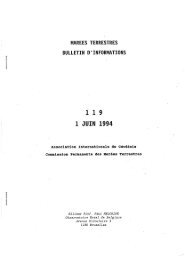marees terrestres bulletin d'informations - Université de la Polynésie ...
marees terrestres bulletin d'informations - Université de la Polynésie ...
marees terrestres bulletin d'informations - Université de la Polynésie ...
You also want an ePaper? Increase the reach of your titles
YUMPU automatically turns print PDFs into web optimized ePapers that Google loves.
Figure 4<br />
Attraction effect from the zones indicated in Fig.2 computed with 3D data from<br />
2007/01/01 to 2007/12/31 (different scaling)<br />
a ) up to 0.5° , b) 0.5°- 1.5° , c) 1.5°- 3.0° , d) 3.0°- 5.0° , e) 5.0° - 10.0° , e) 10.0°-<br />
15.0°<br />
For the innermost zone the maximal amplitu<strong>de</strong> of attraction effect is around 20<br />
µGal and the Root Mean Square (RMS) value is 3.19 µGal. The peak-to-peak<br />
effect from the zone of 0.5° - 1.5° is roughly 1/7 of the innermost zone and the<br />
contribution from the zone of 1.5° - 3° reaches 1/30 of the innermost zone. The<br />
amplitu<strong>de</strong> of the attraction effect from the zone of 3° - 5° has a peak-to-peak<br />
amplitu<strong>de</strong> of 0.3 µGal (Fig.6d), a RMS value of 0.06 µGal and the effect from this<br />
zone is the smallest one. The variations from the zone of 5° - 10° and 10° - 15°



